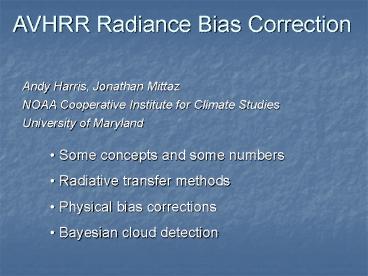AVHRR Radiance Bias Correction - PowerPoint PPT Presentation
1 / 20
Title:
AVHRR Radiance Bias Correction
Description:
SST is a key environmental data record, and also comparatively easy to validate ... that single 'global' linear retrieval equation is regionally sub-optimal ... – PowerPoint PPT presentation
Number of Views:55
Avg rating:3.0/5.0
Title: AVHRR Radiance Bias Correction
1
AVHRR Radiance Bias Correction
Andy Harris, Jonathan Mittaz NOAA Cooperative
Institute for Climate Studies University of
Maryland
- Some concepts and some numbers
- Radiative transfer methods
- Physical bias corrections
- Bayesian cloud detection
2
Some concepts
- SST is a key environmental data record, and also
comparatively easy to validate - SST is traditionally retrieved using
regression-based equations with in situ data used
to train - May get biases in remote regions with sparse/no
in situ data - Also results in least confidence where satellite
data have most impact - New physically-based retrieval methodologies are
reliant on accurate sensor calibration and
characterization - Pursue physically-based methodologies to
- Develop techniques to identify quantify AVHRR
calibration and characterization errors
post-launch - Improve SST retrieval capability
- Feed back results to improve forward modeling for
CRTM
3
Observed and RT-modeled SST biases
Fixed viewing geometry of GOES emphasizes that
single global linear retrieval equation is
regionally sub-optimal
Bias pattern for GOES-W similar to that predicted
by radiative transfer
RTM is a good way of predicting and removing such
biases on a global basis prior to assimilation
4
Impact of restricted training data
5
RTM improvements GOES-9 Case Study
Unusually large scatter and warm bias at low
atmospheric corrections may be due to diurnal
warming
Nighttime retrievals also show small trend vs
atmospheric correction
Updated RT model removes most of the trend
Application of daytime coefficients to nighttime
data gives small ve bias (expected)
6
Diurnal Cycle of SST using ERA-40 fluxes
January 2001
July 2001
Prominent seasonal cycle effect must be taken
into account to ensure bias-free SSTs in
important climatic regions
7
Impact of spectral response error on RT modeling
Impact is greater at high water vapor loadings
Impact is greater at higher scan angles
While top plot shows dependence on temperature,
bottom plot is the key to identifying SRF error
rather than calibration
8
Geographic impact of SRF shifts
9
Results of perturbing NOAA-17 11 12 µm spectral
responses
Daytime split-window
Nighttime split-window
10
Impact of adjusted spectral response
In practice, split-window retrieval will be
replace by physical retrieval method
Triple-window uses adjusted filters as determined
by analysis of 11 and 12 µm data
11
Value of triple-window
With three channels (3.7, 11 12 µm) the SST
retrieval problem is essentially linear
In the daytime, solar radiation contaminates the
signal at 3.7 µm
12
Some Aspects of Calibration
Calibration difference between day and night due
to boost in BB radiance from reflected solar
radiation _at_ 3.7 µm
Digitization of PRTs resolvable if calibration is
recalculated using a running mean _at_ full precision
Variations in scene radiance also affect
calibration
13
Some Aspects of Calibration contd
Warm scene radiances boost perceived BB emission
c.f. cold scenes
Large-scale variation dominated by
center-weighted scene radiance
Small-scale variation shows more sensitivity
where it might be anticipated
Correct calibration can be obtained by
estimating an efficiency for scattered scene
radiance to remove dependency
14
Some Good News on Calibration
Most Daytime and some nighttime calibration of
3.7µm is erroneous, but
Correct calibration i.e. in night-time portion
of orbit is stable (FWHM is 0.05K over 1 day,
including PRT digitization noise)
Derive a single best estimate of calibration
and apply to whole orbit
15
Bayesian Cloud Mask Along-Track Scanning
Radiometer
11µm BT image
Manually screened truth
Threshold-based mask
Bayesian Pclear gt0.99
16
Calculated vs Actual Probability
17
Some results
- Note that a hit rate of 97.2 (Pclear lt 0.99 ?
cloud) corresponds to a failure to detect rate
of 2.8
- Standard threshold-based mask fails to detect
3.7 of cloud-contaminated pixels
What is the impact of these failures to detect
and false arms?
18
Impact on retrieved SST
Computed from 11 cells
Appropriate for climate SST analyses
Cold clear ocean can sometimes be flagged as cloud
Failures of Bayesian scheme tend to have less
impact
19
Probability vs Error in SST
- Bias and scatter improve with increased Pclear
- Significant decrease in coverage as Pclear? 1
20
Summary
- SST is key environmental data record, and also
comparatively easy to validate a powerful tool
for diagnosing AVHRR sensor performance - Pursue physically-based methodologies to
provide - Techniques to identify instrumental calibration
and characterization post-launch - Improved AVHRR SST retrieval capability (inc.
diurnal) - Feed back results to improve forward modeling
- Bayesian cloud detection a promising method for
assigning quantitative errors to individual pixels































